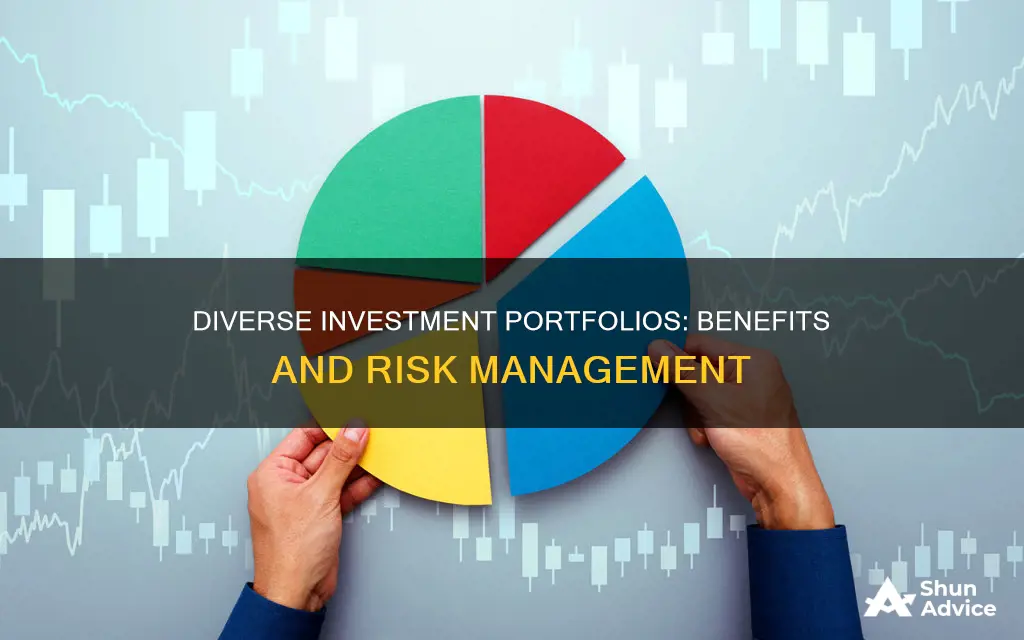
A balanced investment portfolio is a strategy that combines asset classes to balance risk and return. Typically, a balanced portfolio is divided between stocks and bonds, with a small cash or money market component for liquidity purposes. The benefits of a balanced portfolio include protecting your portfolio from the unexpected, limiting downside risk, and avoiding single security risk. For example, if the stock market is performing poorly, bonds tend to move higher in value, thus balancing out the losses. A balanced portfolio can also provide a steady income stream through dividend-paying stocks and interest payments from fixed-income securities. Additionally, a balanced portfolio can help finance an individual's retirement and provide control over their financial future.

Stocks, bonds and cash
A balanced investment portfolio is a coordinated collection of investments, designed to work together to meet a goal. It is a mix of investments, such as stocks, bonds, cash, and real estate, with the goal of generating returns while managing risk.
Stocks, bonds, and cash each have distinct characteristics, and a balanced portfolio will incorporate them in varying proportions depending on the investor's goals and risk tolerance.
Stocks
Stocks are an asset class that generally has strong long-term return potential but is susceptible to severe downturns. They represent ownership in a company, and entitle the shareholder to a portion of the company's profits. Stocks are often riskier than bonds but can generate higher returns.
Bonds
Bonds are a form of loan to a company or government, with an agreement to repay the principal amount plus interest over time. They are typically safer than stocks but tend to generate lower returns. Bonds are a vital component of a well-balanced portfolio, as they provide income and diversification, reducing losses.
Cash
Cash and cash equivalents, such as savings accounts and money market funds, are the lowest-risk and most liquid asset class. They are easily accessible and designed to avoid significant losses. While they may not offer high returns, they provide stability and security within a portfolio.
Benefits of a Balanced Portfolio
A balanced portfolio offers the benefit of coordinating different types of investments, each with distinct risk/reward characteristics. It allows investors to pursue conflicting goals, such as high returns and protection against losses. Additionally, a balanced portfolio provides "one-stop shopping," making it easier to monitor and manage investments.
Drawbacks of a Balanced Portfolio
One criticism of balanced portfolios is the question of whether a single investment firm can effectively manage different types of investments. Some argue that it is better to find specialists for each investment class. Additionally, balanced portfolios may not be the most cost-effective approach, as riskier investments like stocks tend to have higher management fees, resulting in potentially unnecessary costs for more conservative assets in the portfolio.
Creating a Schedule for Investment Savings
You may want to see also

Risk tolerance
When assessing risk tolerance, it is important to consider both the objective and subjective aspects. Objectively, an investor's net worth, income, and financial obligations play a role in determining their capacity to take on risk. Subjectively, an investor's risk tolerance is influenced by their personality, emotional response to market fluctuations, and willingness to accept volatility in pursuit of higher returns.
For example, younger investors in their 20s typically have a higher risk tolerance. They can afford to take on more risk due to their longer investment horizon, which allows time to recover from potential market downturns. As a result, younger investors may allocate a larger portion of their portfolio to stocks and other higher-risk, higher-return investments.
On the other hand, investors approaching retirement age or with more conservative financial goals tend to have a lower risk tolerance. They may seek to preserve their wealth and generate stable returns, opting for more predictable and less volatile investments. Their portfolios may be skewed towards bonds, dividend-paying stocks, and other stable income-generating assets.
It is important to note that risk tolerance can change over time as an individual's financial situation, goals, and market conditions evolve. Therefore, it is crucial to regularly review and rebalance one's investment portfolio to ensure it remains aligned with their risk tolerance and investment objectives.
Additionally, risk tolerance is closely tied to the concept of diversification. By diversifying across different asset classes, sectors, and company sizes, investors can manage and mitigate risks. Diversification helps reduce the impact of systematic risks, such as market downturns or economic events, and nonsystematic risks, such as company-specific or industry-specific issues.
Strategies to Optimize Your Investment Portfolio Performance
You may want to see also

Diversification
There are several ways to diversify your portfolio. Firstly, you can invest in a range of asset classes, including stocks, bonds, cash, and real estate. Stocks, or equities, are generally considered riskier but offer higher potential returns, while bonds are typically safer but generate lower returns. Cash and cash equivalents, such as savings accounts and money market funds, are low-risk and highly liquid. Real estate can be a good investment for income generation or long-term appreciation but is relatively illiquid.
Secondly, you can diversify within each asset class. For example, if you invest in stocks, you can diversify across different sectors, company sizes, and geographic locations. If you invest in bonds, you can diversify across various maturities and qualities, including government and corporate bonds.
Another way to achieve diversification is by investing in mutual funds, exchange-traded funds (ETFs), or index funds, which are themselves diversified across multiple securities. These funds offer a convenient way to gain exposure to a diversified portfolio of assets.
Savings Investment Strategies: Accessibility and Growth
You may want to see also

Asset allocation
Understanding Risk Tolerance
Knowing your risk tolerance is fundamental to building a robust asset allocation strategy. Your risk tolerance refers to the amount of risk you are comfortable taking in your investments. It is influenced by factors such as your age, financial goals, and personal circumstances. Younger investors with a longer investment horizon often have a higher risk tolerance, seeking higher returns and willing to tolerate volatile asset prices. On the other hand, older investors or those nearing retirement typically have a lower risk appetite, focusing more on capital preservation and stable assets.
Diversification
Diversification is a risk management strategy that involves spreading your investments across various asset classes, sectors, and industries. By diversifying your portfolio, you reduce the impact of systematic risks, such as economic downturns or political events, and non-systematic risks, such as company-specific or industry-specific issues. Diversification helps protect your portfolio from significant losses and provides a more stable foundation for long-term growth.
Core-Satellite Strategy
A core-satellite strategy combines a core portfolio of stable, low-risk investments with a smaller proportion of higher-growth or more volatile assets. In this approach, investors often seek the expertise of experienced investment professionals to manage the core portfolio, while they retain direct control over the satellite assets, allowing them to explore their investment ideas.
Regular Rebalancing
Over time, the balance of your portfolio can shift due to the fluctuating performance of different assets. Regular rebalancing ensures that your portfolio stays aligned with your desired asset allocation and risk tolerance. You can rebalance by selling certain assets and investing the proceeds in underweighted asset classes or by allocating additional funds to those areas.
Choosing the Right Asset Mix
The specific mix of assets in your portfolio depends on your individual circumstances and goals. Stocks, for example, tend to offer higher returns but come with higher risk. Bonds, on the other hand, are generally considered safer but generate lower returns. Cash and cash equivalents are low-risk and highly liquid, providing easy access to funds. Other assets such as real estate, commodities, and alternative investments can also be included in your portfolio to further diversify and balance risk and return.
Strategies to Optimize Your Investment Portfolio's Performance
You may want to see also

Long-term goals
A balanced investment portfolio is essential to achieving your long-term goals. Here's how:
When it comes to long-term goals, such as saving for retirement, a balanced investment portfolio can be a powerful tool. The key to achieving these goals is to start early and allow your investments to grow over time. Here are some benefits of a balanced portfolio for long-term goals:
- Risk management: A balanced portfolio helps you manage market risk. By diversifying your investments across different asset classes, such as stocks, bonds, and cash, you reduce the impact of market volatility on your portfolio. This is especially important for long-term goals, as it helps smooth out the ups and downs of the market over time.
- Maximizing returns: While managing risk, a balanced portfolio also maximizes your return potential. By allocating your investments based on your risk tolerance and goals, you can take advantage of the growth potential of different assets. For example, stocks typically offer higher returns over the long term, making them ideal for long-term goals.
- Time in the market: Starting early gives your investments time to grow and compound. The power of compound interest is significant, especially over several decades. By investing in a balanced portfolio early on, you benefit from the effects of time, which can turn small initial investments into substantial savings over time.
- Rebalancing: A balanced portfolio requires regular rebalancing to stay aligned with your goals. Over time, the performance of different assets will vary, causing your portfolio's allocation to drift from your initial plan. By rebalancing, you ensure that your portfolio remains tailored to your long-term goals and risk tolerance. For example, if stocks have outperformed bonds, rebalancing may involve selling some stocks and investing the proceeds in bonds to return to your desired allocation.
- Peace of mind: A well-balanced portfolio that considers your risk tolerance and goals provides peace of mind. Knowing that your investments are diversified and managed according to your plan helps you stay focused on your long-term objectives without being overly concerned about short-term market fluctuations.
- Adaptability: A balanced portfolio is adaptable as your life circumstances change. As you progress through life, your financial situation, goals, and risk tolerance may evolve. A balanced portfolio allows you to adjust your investments accordingly, ensuring that they remain aligned with your updated long-term goals.
In summary, a balanced investment portfolio is a powerful tool for achieving your long-term goals. It helps you manage risk, maximize returns, and benefit from time in the market. By regularly rebalancing and adapting your portfolio, you can stay on track toward your goals while enjoying the peace of mind that comes with a well-planned investment strategy.
Strategies for Generating Investment Portfolio Leads
You may want to see also
Frequently asked questions
A balanced investment portfolio is a strategy that combines asset classes to balance risk and return. Typically, this involves dividing investments between stocks and bonds, with a small cash or money market component for liquidity. The aim is to balance capital preservation and growth, and it is suited to investors with moderate risk tolerance.
A balanced investment portfolio can help protect your investments from unexpected events and limit downside risk. By diversifying your investments across asset classes, you reduce the impact of a decline in any one particular stock or asset class. Additionally, a balanced portfolio can provide a steady income stream through dividend-paying stocks and interest payments from bonds.
To create a balanced investment portfolio, you need to determine your risk tolerance and investment goals. Generally, a balanced portfolio will have an even split between stocks and bonds, such as a 50/50 or 60/40 mix. You can also consider the geographic allocation of your investments, diversifying across different countries. Regular portfolio reviews are important to ensure it remains balanced over time.







